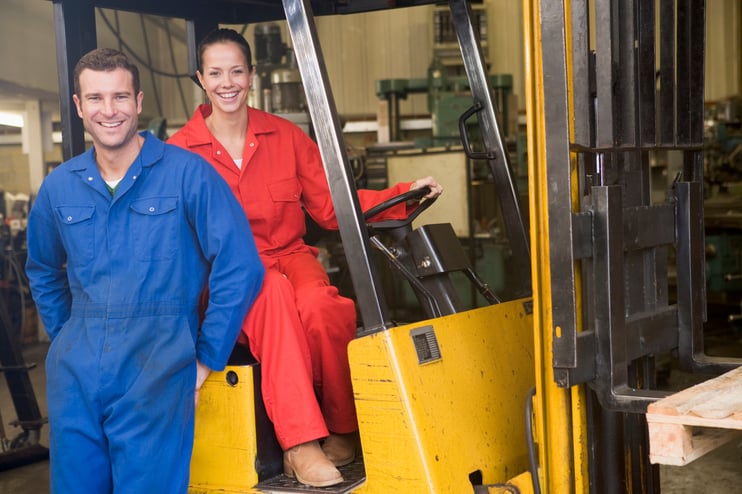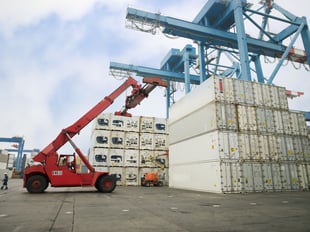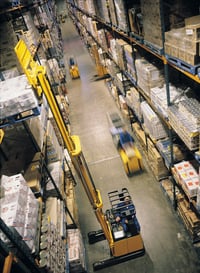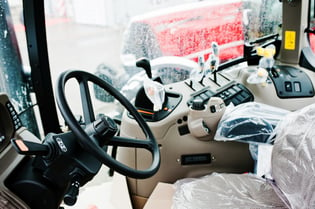
There is good news and bad news for anyone purchasing a forklift. First, the good news: there are dozens of web sites providing advice about purchasing new and used forklifts. Now, the bad news: there are dozens of web sites providing advice about purchasing new and used forklifts. The breadth and depth of online information is truly overwhelming.
Researching a forklift purchase is different than researching most other goods. If one searches for “top rated cars,” Google returns 16M results. On the other hand, entering “top rated forklifts” is about as fruitful as looking for “top rated vacuums” — 648,000 and 729,000, respectively. There is also a huge contrast in the types of informational sources.
Car reviews are generated by consumer watch dogs (e.g. Consumer Reports), trade groups (Edmonds or Kelly Blue Book), and magazines (Car and Driver) while vacuum reviews are written by consumers on retail sites (Amazon or Best Buy) and critics comparable to those reviewing autos.
 Not so for forklifts. In fact, most online reviews contain the “top rated forklift companies” versus useful comparisons of makes and models echoing performance results like a NASCAR race or Ironman (men and women).
Not so for forklifts. In fact, most online reviews contain the “top rated forklift companies” versus useful comparisons of makes and models echoing performance results like a NASCAR race or Ironman (men and women).
Thankfully, Side by Side Reviews came to the rescue with its “Best Forklift Review 2016.” In its own words, “Side By Side Reviews was developed to help businesses and consumers find valuable information and get buying advice about products, services and companies before making buying decisions. Our site is made up of buying tips, informational articles, internal reviews/opinions and visitor comments based on personal experiences.” Unfortunately, there are few other comparative resources in this segment of the heavy equipment industry.
Considering the online trend of focusing on pre-purchase checklists and the fact that many dealers sell models from different manufacturers, CrossCheck cherry-picked the best advice and distilled it down to a digestible form with the help of a professional. Elaine DePalma is a regional sales manager at Pacific Materials Handling Solutions in Union City, California whose territory stretches from Sonoma County to Monterey County.
The Pre-purchase Checklist
Start by determining and documenting basic needs and parameters:
- Monetary budget (short- and long-term)
- Time budget (how much time is available for research, maintenance, driving to and from the dealer, training and more)
- Anticipated term of this purchase (How many years is it intended to last?)
- Location of nearest dealers and/or repair services
 Next, research the subject “purchasing a forklift” until a strong familiarity with the product is acquired. CrossCheck found bits and pieces of information at several sites, but very detailed advice at Purchasing.com, adaptalift and surprisingly, eBay. While the subject is not exceptionally complex, the number of options is huge, so anticipate spending three or four hours reviewing the factors that will lead to a successful purchase.
Next, research the subject “purchasing a forklift” until a strong familiarity with the product is acquired. CrossCheck found bits and pieces of information at several sites, but very detailed advice at Purchasing.com, adaptalift and surprisingly, eBay. While the subject is not exceptionally complex, the number of options is huge, so anticipate spending three or four hours reviewing the factors that will lead to a successful purchase.
DePalma likes to dig deep into customer practices and needs before making recommendations. “I ask a lot of questions to determine how, when and where the equipment will be used,” she said.
Her qualifying questions include the following:
- Will the lift be operated indoors or outdoors?
- Are there wet, dry, gravel or paved surfaces to consider?
- How wide and high are the doors and aisles where the lift will be used?
- How distant are the operating runs? (This can affect down time between charges and the battery size.)
- What is being moved and how heavy is it?
- What is the sensitivity of the loads? (i.e. Are there camera prisms or loose pallets to consider?)
- Will the lift be removing loads out of containers, off flatbed truck, or just across the warehouse?
Product Options
Types of Lifts The heavy equipment industry makes a variety of lift types to address a spectrum of needs: pallet jacks, order pickers, reach trucks or sit-down rider trucks. Purchasing.com clearly explains each category.
Tires Forklifts offer three distinct types of tires, all with different applications, advantages and disadvantages: cushion, pneumatic or solid pneumatic (see the above eBay link for an excellent crash course).
Power Supplies Modern forklifts are equipped with four engine types: internal combustion engines (ICE), electric, fuel cell or dual fuel (gas and propane or diesel and electric). Only ICE are capable of lifting loads over 50 tons or reaching heights of 36 feet, but they must operate outdoors. Electric lifts cost 20-40% more than ICE units upfront, but they are cheaper to run by the hour. Hydrogen fuel cells offer zero emissions, quiet operation and fast refueling. They are the future.
Weight Capacity Determine the weight and proportion of your typical load. Lifts rated at 5,000 pounds are the industry standard, but unusually long or high loads require greater lifting capacities to compensate for the adjusted center of gravity.
Operational Height Determine the required height of your work area. Standard sit-down forklifts can lift huge loads to heights of 36 feet, but they have large footprints that may not fit in tight spaces. On the other hand, reach trucks are common in home improvement stores because they offer capacities up to 5,500 pounds, relatively small footprints and about 30 feet of reach.
Purchasing Options
Types of Sellers Resources for buyers include new dealers selling one or more brands, certified used dealers, small business owners, fleet owners, and online sources such as eBay, craigslist or Ritchie Brothers Auctioneers.
 New or Used The budget and expected use of the lift determine if it is better to purchase new or used, lease or rent. New units offer better “curb appeal,” reliability, the latest features and safety equipment, warranties and lower repair costs while used machines favor infrequent use, tight budgets and wider selections.
New or Used The budget and expected use of the lift determine if it is better to purchase new or used, lease or rent. New units offer better “curb appeal,” reliability, the latest features and safety equipment, warranties and lower repair costs while used machines favor infrequent use, tight budgets and wider selections.
“Buy a used lift if it will only be operated two to four hours per day,” said DePalma. She suggests buying a new machine if it’s needed 18 hours per day. “Prospective buyers should also consider adding multiple batteries or different charging systems.” Charging options include fast charge, opportunity charge (e.g. during employee breaks) and the standard method.
Service Agreements Proof of regular service and maintenance will lead to a “long, healthy life expectancy” for a forklift whether it is purchased new or used. Purchasing.com recommends finding a dealer less than 50 miles from your location with certified technicians, name-brand parts, service programs, warranty of parts and service, 24/7 customer support, convenient service hours, and operator training and certification. Dealers should also provide insurance for their mechanics while repairing equipment away from their service department.
Furthermore, complete maintenance records from a reputable dealer will serve the buyer when it comes time to sell the machinery. If more than one lift is needed, there are two advantages to buying one brand: lessen the learning curve for operators, and have the equipment maintained and repaired by a single service department.
The Art of Buying Used
Pre-Inspection Once a buyer finds a make and model suits their needs, it’s important to secure all of the critical background information: age of the vehicle, age of batteries (if electric), spec sheets, complete maintenance and repair records, operation logs (key hours and dead-man hours if electric), condition rating, list of attachments, and photos of all angles and components (if the listing is online). This is also the time to ask any or all questions to the seller.
Physical Inspection Ideally, it is best to have a journeyman mechanic conduct the physical inspection, especially one familiar with the make and model. If a technician is not available, there is a lengthy list of items to review during the inspection. “Bringing a trusted advisor is the best thing buyers can do,” said DePalma.
Exterior checks include tires, counter weights, engine and engine oil, wiring and electrical components, coolant and other fluids, brakes, forks, mast assembly, chains and rollers, hydraulic lines and cylinders, hour meter, flood lights, alarm, chassis number, rating plate, dents and paint, and signs of damage such as cracks or welds. In the operator’s compartment, inspect the condition of the controls, gauges, seat, seat belt, windows and flooring.
Test Drive Here is where the rubber literally meets the road. Sit in the operator’s seat and fasten the safety belt. The seat should be adjustable and remain in a locked position. Note the “feel” of the controls and pedals — unusually loose or sloppy components could spell trouble.
Start the engine. If it’s an internal combustion engine, then look for excess smoke emitting from the exhaust pipe. Listen for rattles or unusual sounds like taps, knocks or pings. Operate all hydraulic levers to insure the proper movement of the mast through all of its functions.
Now drive the lift forward and back in straight and circular patterns as one does under normal conditions while noting the acceleration, braking power and steering. If amenable to the seller, lift a moderate load to insure smooth operation versus shaking. Finally, turn off the engine and look for fluid leaks or other anomalies.
Government Regulations If purchasing from a certified dealer, determine that the lift complies with EPA emission standards.
Trade-in and Disposal Also inquire about the trade-in value of your old lift or its disposal if destined for the scrap yard.
Agreement Before signing on the dotted line, ensure that the terms, conditions and warranty meet your expectations. If anything doesn’t seem right or fair, reschedule the signing after you’ve had time to review your concerns. As the saying goes, “show them your back” if you’re not receiving a square deal.
Negotiating the deal is a great time to inquire about flexible payment options such as CrossCheck’s Multiple Check service. In fact, Multiple Check is a great way to help your customers make critical down-payments without breaking the proverbial bank, especially if you are in the building materials industry.
The customer writes 2 – 4 checks at the time of purchase that are deposited by the dealership over 30 days. Checks are simply approved on the spot via terminal, phone or the web. It’s not financing, but it is a win-win for both the seller and the buyer. Learn how it can increase sales at your business by contacting us for a consultation.



